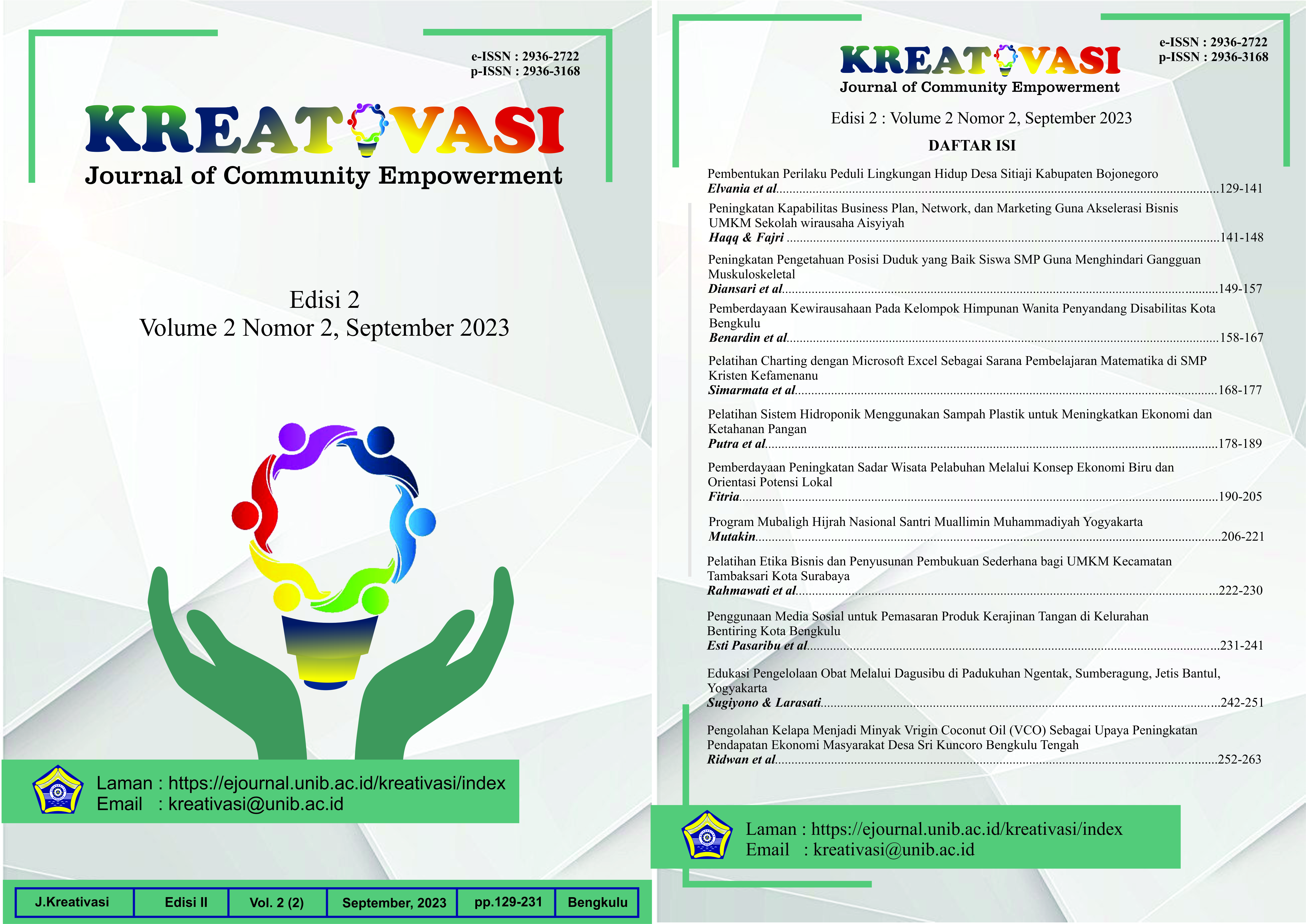Main Article Content
Abstract
The purpose of this community service is to test and train the community on the technology of making high protein fish feed pellets from trash fish waste which is useful for reducing the high purchase of fish feed on the market. Therefore, the need for a technology or innovation for the manufacture of fish feed in the community, especially areas where there is fish farming and is expected to reduce the high cost of purchasing feed. The method consists of presentations or training, mentoring and discussions, as well as analysis of business benefits. Members of the catfish breeding partners are mostly aged between 18 to 68 years, have elementary, junior high and high school education. The raw materials for the waste are 5 kg of dry trash fish, 100 g of tapioca flour/0.1 kg, 4.9 kg of rice bran and 1 l of diesel oil and plastic, so you can get up to 8 kg of fish pellets. with the cost required is IDR 39,050 Gross income IDR. 72,000 and a profit of Rp. 32,950. Comparing the benefits and costs incurred is IDR 32,950.00 :I DR 39,050.00 = 0.8 (B/C). Therefore, the fish pellet business is very profitable to develop and can increase the income of the Jati Emas villagers.
Keywords
Article Details
Copyright (c) 2023 Syahrinur Fitriah, Nurida Isnaeni

This work is licensed under a Creative Commons Attribution-ShareAlike 4.0 International License.
- This statement is a commitment from the author, to respect copyright, both in terms of quoting the work of others, as well as in the use of journal content.
- If needed, the author can send a statement of authenticity of the manuscript. With the receipt of an article by the Editor of Kreativasi - Journal of Community Empowerment, the article submitted has the copyright held by Kreativasi - Journal of Community Empowerment:
- Kreativasi - Journal of Community Empowerment has the right to reproduce and distribute articles that have been published in journals.
- The author is not permitted to publish the same article that has been published in this journal.
References
- [BSN] Badan Standarisasi Nasional. 2006. SNI 01-4087-2006 tentang Pakan Buatan untuk Ikan Dumbo (Clarias gariepinus) pada Budidaya Intensif
- [BSN] Badan Standarisasi Nasional. 2006. SNI 01-4266-2006 tentang Pakan Buatan untuk Ikan Mas (Cyprynus carpoi L) pada Budidaya Intensif
- [BSN] Badan Standarisasi Nasional. 2009. SNI 7548: 2009 tentang Pakan Buatan untuk Ikan Patin (Pangasius sp.)
- Menteri Perindustrian dan Perdagangan Republik Indonesia. 1997. Keputusan Menteri Perindustrian dan Perdagangan No. 231 Tahun 1997 tentang Prosedur Limbah Impor Pasal 1
- Soedibyo, P.H.T. (2013). Ikan nila gift Oreochromis niloticus yang diberi pakan mengandung probiotik. Jurnal Aquakultur indonesia. 12(2):106-112.
- Standar Nasional Indonesia 01-7242-2006. (2006). Pakan buatan untuk ikan nila (Oreochromis spp.) pada Budidaya Intensif.. Direktorat Perbenihan, Departemen Kelautan dan Perikanan. Jakarta.
- Victoria, A. O. (2019). Kementerian KKP Keluhkan Generasi Milenial Tak Tertarik Bidang Perikanan. Diakses dari https://katadata.co.id/berita/2019/10/12/kementerian-kkp-keluhkan-milenial-tak-tertarik-bidang perikanan/
- Wilson, R.P. (2002). Amino acids and proteins. Di dalam; Halver J, Hardy RW, editors. Fish Nutrition. London, New York: Academic Press. hlm 143- 179.
- Winarno. 2002. Kimia Pangan Dan Gizi. PT Gramedia Pustaka Utama. Jakarta. 253 Halaman.
- Zhou, Q.C., Tan, B.P., Mai, K.S., Liu, Y.J. (2004). Apparent digestibility of select feed ingredients for juvenile cobia Rachycentron canadum. Aquaculture. 241:441-451.
References
[BSN] Badan Standarisasi Nasional. 2006. SNI 01-4087-2006 tentang Pakan Buatan untuk Ikan Dumbo (Clarias gariepinus) pada Budidaya Intensif
[BSN] Badan Standarisasi Nasional. 2006. SNI 01-4266-2006 tentang Pakan Buatan untuk Ikan Mas (Cyprynus carpoi L) pada Budidaya Intensif
[BSN] Badan Standarisasi Nasional. 2009. SNI 7548: 2009 tentang Pakan Buatan untuk Ikan Patin (Pangasius sp.)
Menteri Perindustrian dan Perdagangan Republik Indonesia. 1997. Keputusan Menteri Perindustrian dan Perdagangan No. 231 Tahun 1997 tentang Prosedur Limbah Impor Pasal 1
Soedibyo, P.H.T. (2013). Ikan nila gift Oreochromis niloticus yang diberi pakan mengandung probiotik. Jurnal Aquakultur indonesia. 12(2):106-112.
Standar Nasional Indonesia 01-7242-2006. (2006). Pakan buatan untuk ikan nila (Oreochromis spp.) pada Budidaya Intensif.. Direktorat Perbenihan, Departemen Kelautan dan Perikanan. Jakarta.
Victoria, A. O. (2019). Kementerian KKP Keluhkan Generasi Milenial Tak Tertarik Bidang Perikanan. Diakses dari https://katadata.co.id/berita/2019/10/12/kementerian-kkp-keluhkan-milenial-tak-tertarik-bidang perikanan/
Wilson, R.P. (2002). Amino acids and proteins. Di dalam; Halver J, Hardy RW, editors. Fish Nutrition. London, New York: Academic Press. hlm 143- 179.
Winarno. 2002. Kimia Pangan Dan Gizi. PT Gramedia Pustaka Utama. Jakarta. 253 Halaman.
Zhou, Q.C., Tan, B.P., Mai, K.S., Liu, Y.J. (2004). Apparent digestibility of select feed ingredients for juvenile cobia Rachycentron canadum. Aquaculture. 241:441-451.
